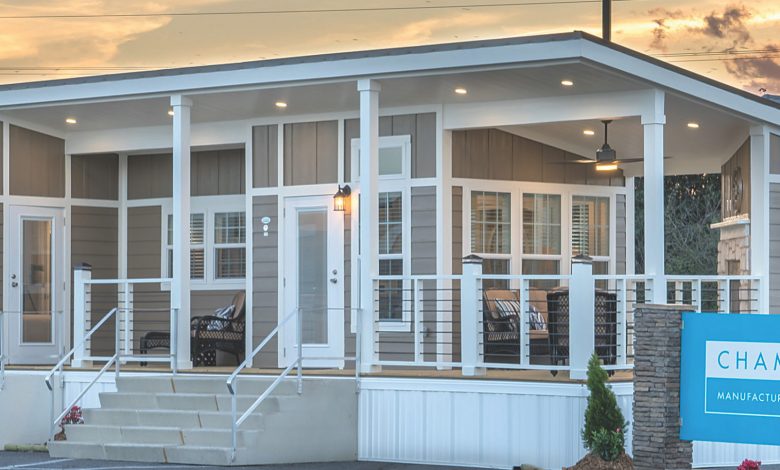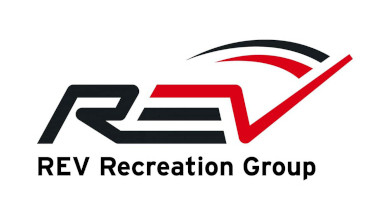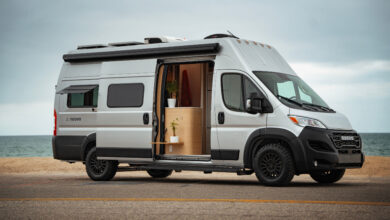Park Models on the Move

If the word “momentum” can be assigned to a type of RV that’s built and then hauled to a site where it might stay for its lifespan, then the park model segment could certainly boast that it has “the big mo” this year.
Coming off its second straight year of year-over-year shipment growth and its fourth growth year in the past six (see Figure 1 on page 14), the park model industry has a lot of positive factors on its side, including continued low interest rates, an improving reputation among formerly skeptical lenders and government agencies, and ongoing manufacturer consolidation, which promises to make best practices an almost industry-wide reality.
Wholesale shipments in 2017 bested 2016’s by almost 10 percent and topped 4,000 for the first time since 2008, according to the RV Industry Association, whose 29 members account for at least 95 percent of the entire industry’s shipments.
One leading park model builder, Curt Yoder, co-owner of Goshen, Ind.-based Kropf Industries, projects shipments will rise another 10 percent to 15 percent this year.
That being said, the park model business is still a small niche market. The 4,000 shipments represent less than 1 percent of the 504,590 total RVs shipped in 2017. Computing an average retail price of $50,000 per unit, those 4,000 units would represent about $200 million in retail sales.
But unlike other segments of the RV industry – where “the Big 2” (Forest River and Thor Industries) dominate – since Thor elected to exit the park model market a few years back, there has been a hearty competition among the survivors.
Like other park model manufacturers, Champion includes plenty of residential-style features in its models, including stainless-steel appliances in the kitchen.
According to industry sources, Phoenix-based Cavco Industries and Troy, Mich.-based Champion Home Builders are the leading park model manufacturers in the U.S. With the combination of Champion and Skyline Corp. in the works as this issue of RV PRO went to press, the leaderboard could have a clear frontrunner sometime later this year, if the company decides to combine its sales for reporting purposes.
Meanwhile, Texas, California and Arizona are the top destinations for park models, with these markets primarily served by Cavco and Champion.
As the season unfolded, park model builders were concerned with rising material costs, such as for lumber and lauan.
Recently, RV PRO spoke with three of the leading firms for their take on business.
 Kropf Industries
Kropf Industries
Kropf Industries has stood near the top of the park model leader board for much of this decade, thanks to a business model that Yoder says stresses quality, the flexibility to build more than 100 different floorplans, and a steady production schedule that doesn’t waver much from year to year.
Founded in 1946 by Solomon Kropf to build manufactured housing, the company diversified into park models in the mid-1970s under the direction of his sons, Vern and Bob. Don Kropf (Bob’s son) and his brother-in-law, Yoder, are now 50-50 owners of this Goshen, Ind.-based manufacturer.
“Our expectations are what they’ve been for the last several years,” says Yoder, who is the vice president of the company. “We build 10 units a week, 450 to 470 units a year, like clockwork. I don’t see that changing. We have increased slightly every year for the last 15 years. Even in 2008 and 2009, we were only down 15 percent. That says something about our product.”
That product is spread over four lines: the top-of-the-line Island Series, mid-range Lakeside, the economical Lakeside LE, and a larger Canadian series for its Canadian customers.
For 2018, these models feature some new cabinet packages and new accent wall enhancements.
“We keep close tabs on the residential market and try to keep on top of what’s happening in those markets,” Yoder says. “Our dealers come to expect us to stay ahead of the game. We change our decors yearly and are constantly tweaking them.”
Kropf sells through a 50-member dealer body, which sells primarily to RV parks and campgrounds across the U.S. and Canada, with the majority of that business in the Midwest, East and New England, according to Yoder. He describes his dealer body as predominantly full-time dealers who also carry other towables and motorized units. About 25 percent of retailers carry park models exclusively, including his top dealer.
Yoder says Kropf has a five-month order backlog – much of which is custom work.
“With the mix we build, there is only so much we can do with our 60-member workforce,” he says. “Labor continues to be an issue. We have to make some tough decisions: Do we expand? What do we do to increase our output?
“That’s a slippery slope; we remember what happens in slow times; you create a monster you have to feed,” he adds.
Yoder takes pride in Kropf ’s ability to compete against the larger, publicly held firms such as Cavco, Skyline and Champion – all of which have multiple plant sites and penetrate markets that Kropf has chosen to leave alone.
Yoder has been active in industry affairs and serves on the RVIA Board of Directors. He notes that the RVIA lobbies on the state and federal level to get park models recognized as RVs instead of manufactured housing. RVIA stresses that park models are not meant to be permanently affixed to the property, they do not improve property values in any way, and they are neither designed nor intended by their manufacturers to be used as permanent residences.
“We’re working hard to change that perception” that park models are permanent residences, says Yoder. “Our product is designed to be parked. A lot of finance companies look at people living in these units, but it’s really no different from travel trailers or fifth wheels that are parked permanently in a campground. We’re gradually getting more and more financial companies to look at park models as RVs. It’s still a work in progress.”
Yoder says he sees steady growth ahead for the park model industry.
“The whole destination camping concept is still in its infancy,” he says. “There is a lot of virgin territory out there we haven’t touched. I think we’ll see the destination market still growing.”
The market for park models is evolving, according to Yoder.
A generation ago, “80 percent or better were retirees,” he says. “That has changed a bit over the last 10 years as the destination camping craze became more prevalent. As people realize park models and park trailers are a viable and affordable option, we’re seeing the age vary. Retirees are still the majority, but it’s closer to 45 to 65 percent, as a lot of families are purchasing them.”
Yoder says he sees three factors constraining the market going forward: He’s concerned about the lack of new campgrounds and RV parks opening up. He says the pool of qualified workers in the Elkhart area seems to be getting smaller.
And he fears the growing popularity of Internet sales. On the latter, he says, “I’m dead set against it – especially on the park model end. Park models are different from travel trailers, yet some companies are selling directly off of the Internet. That is not good for our dealers.”
Meanwhile, Kropf will be showing 2019 models at its facility in Goshen during Elkhart Open House Week.
Athens Park Model RVs
Athens Park Model RVs – the leading brand of parent company Champion Home Builders – could be the best positioned of all the park model builders. Athens has nine plants strategically placed across the U.S., so that every market is covered, according to Dick Grymonprez, director of park model sales for Athens Park Model RVs.
In 2016, Athens recorded its best year since its founding in 2004 and then “blew away” those numbers in 2017, Grymonprez says. Thus far, 2018 is off to a good start.
Of the industry’s 4,000 homes shipped in 2017, Grymonprez estimates Athens built close to a fourth of them. He says he believes that Athens’ success has buoyed the industry numbers the past two years.
“In 2016, we grew 30 percent and the entire industry grew 10 percent. Last year, we grew 15 percent and the industry grew by 10 percent,” he says.
Where are these Athens units going?
More than 50 percent of Athens’ production used to end up in campgrounds. Today, that share has shrunk to between 30 percent and 40 percent. The majority is going onto private property, which is counter to the industry norm.
“What’s really happened to our company is that the tiny home market has gotten people interested in smaller-type units,” he says. “We’re getting so much more traffic from retail customers for weekend getaways and vacation homes. Our extra business has been retails. In some states, maybe we had one dealer, but we may have six dealers now. The tiny home market has drawn customers to us. Then, we educate them that a park model is better than a tiny home – but we don’t sell our product as housing.”
In March, Athens debuted at a retail show in Tunica, Miss., a new 12-foot-wide model on a 15-foot frame that features a 10-foot-long front porch with a wood-burning fireplace and a side porch.
“It looks huge, but it’s still under 400 square feet,” Grymonprez says.
Inside features include a king-size bed, his and hers barn door closet doors, 48-inch walk-in tiled shower, farmhouse kitchen sink, Euro-style range hood and an appliance garage beneath the microwave.
The unit will retail for about $75,000. It was built at Athens’ Mansfield, Texas, plant but could be built at other plants moving forward. Because of transportation limitations, he suspects production and sales will be limited to the South.
Grymonprez says the park model industry still could use more retail financing. He commends 21st Mortgage Corp. based in Knoxville, Tenn., as a prime lender in this sector, but says there remains an absence of low-cost, easy-to-get-into financing for park model shoppers.
Today’s park models feature modern, residential-style kitchens; bathrooms with double sinks, plus tiled, walk-in showers and fancy showerheads; residential-style front doors with built-in blinds instead of the standard “patio door” and porches.
“Eighty percent of the park models we build have porches,” Grymonprez says. “We find customers are willing to pay an extra $3,500 to put their lawn chairs and a gas grill on,” so price creep does not appear to be an issue.
Another new feature in recent years for a lot of builders is the mini split heating and air conditioning units, which eliminate the need for floor ducts. This feature adds about $1,000 to the heating and cooling price, but is quiet and efficient and has become a staple in as many as 80 percent of today’s park models, Grymonprez estimates.
For units not going to campgrounds, today’s typical retail customer is “a middle-aged couple looking for a weekend getaway where the family can meet and enjoy the outdoors. A lot of states allow park models on private property as long as they’re not lived in full-time. We’re still selling to snowbirds. It would seem that the park model customer is a bit different from your traditional RVer but I could be wrong.”
The typical park model dealer also is changing. It used to be just the few who sold park models only, but now RV dealers in general are selling park models because they see the added extra business potential, according to Grymonprez. Others are joining in, including dealerships that sell storage buildings and some manufactured housing dealers.
Athens Park Model RVs will again participate in the “Park Model Village” at the Elkhart County Open House in September. Grymonprez suspects that Athens’ plants in Pennsylvania and Minnesota will provide the units, giving dealers more options. Giving more options from a single company, as well as featuring more companies, will help draw more dealers to Open House, he says.
Forest River
Ask Gary Duncan, general manager of Forest River’s Park Model Division, how business is going and one gets an encouraging answer: “It’s starting off better than I can remember since I joined the company in 2011.”
A strong U.S. economy and an improving economy in Canada – where the division does approximately 40 percent of its business – are key factors in this year’s fast start, according to Duncan, whose division was one of the founding pillars when Pete Liegl established Forest River in 1996.
Duncan has a mere 33 workers on his production line in a 38,000-square-foot factory in Elkhart, but he says the team routinely builds eight units a week, and the output helps make the division in the top three in every market it competes in: the Midwest, the East Coast and New England and Canada.
Freight costs, which can run as high as $9,000 per unit for trucking to the West Coast, preclude profitable marketing to the West, Southwest and deep South, he notes. Nevertheless, the company has made occasional sales in Colorado, Arizona and even in Alberta, Canada.
Speaking of Canada, that Canadian market has been a treasure trove since the Canadian economy rebounded, according to Duncan. His largest dealer is in Ontario.
Forest River builds six brands: the top-of-the-line Quailridge, the entry-level Summit, a larger Quailridge and Summit for Canadian customers, and the America’s Park Cabins Lodge series and America’s Park Cabin Premium Cabins series rental cabins for KOA and other campgrounds.
MSRPs on the Summit range from $35,800 to $47,100, on the Quailridge from $45,400 to $57,500 for some loft units and on the Lodge Series from $57,500 to $63,400.
Duncan’s dealer body is comprised of retail dealers who sell primarily park models, campground owners who serve as retail dealers selling to neighboring campgrounds and campgrounds that rent their units.
Either way, most Forest River park models end up in campgrounds. Forest River’s most successful dealers specialize in park models, according to Duncan.
“It’s a different customer than the typical RV buyer; a park model is usually the last RV they’re going to buy,” he notes.
Duncan says many models sold as rentals don’t get registered, and rentals are a growing segment of the park model business. Also, because the park model segment is really a niche market (given its 4,000 annual unit production) – even small changes in retail numbers tend to have a larger impact in the statistics than for the big volume towable market.
For these reasons, he says the retail picture depicted by Statistical Surveys data is somewhat clouded.
Duncan concedes that the limits on where a park model can be parked continue to hamper the industry.
“Some campgrounds don’t allow park models in,” he notes. “A lot of people want to put them on private property. That can be a problem because whether you can or can’t is determined by local building codes. Most often, you can’t.”
The biggest change for Forest River has been “the amount of customization we’re asked to do. We take pieces and parts of various floorplans or maybe a different manufacturer’s floorplan and are asked to put it together. Extra tall people want higher bathroom and bedroom ceilings. Bigger people want bigger doorways. They want ‘this’ kitchen versus a standard kitchen. And they specify cabinet placement.
“We accommodate them where we can,” Duncan adds. “That’s where the market is today. Nobody’s building a cookie cutter today. That makes it difficult for purchasing and manufacturing to keep up. Forest River was not known for that before. We have turned that around and are willing to accommodate them as long as it does not violate code or create a liability issue.”
This willingness to customize could be one of the keys to its successful Canadian penetration. In the U.S., park models must remain under 400 square feet to qualify as an RV under federal and state laws. However, in Canada, park models can go up to 538 square feet, so the units are wider and longer than their U.S. counterparts. This greater flexibility allows features such as king beds, a second bedroom and larger living rooms.
Looking ahead, Duncan and his staff were conjuring up the next eye-popping surprise for the Elkhart Open House Week in September.
In 2016, Forest River wowed its dealers with a limited edition “barn unit” at the Elkhart show. That limited edition was so popular that it was being built well into 2018. It’s time to retire that very successful design and show a new special unit during Open House Week, according to Duncan.
“We will try to do something that catches your eye. Our goal at Expo is to ‘wow’ again by showing things you haven’t seen in a park model,” he says. “We’re formulating that plan right now.”


